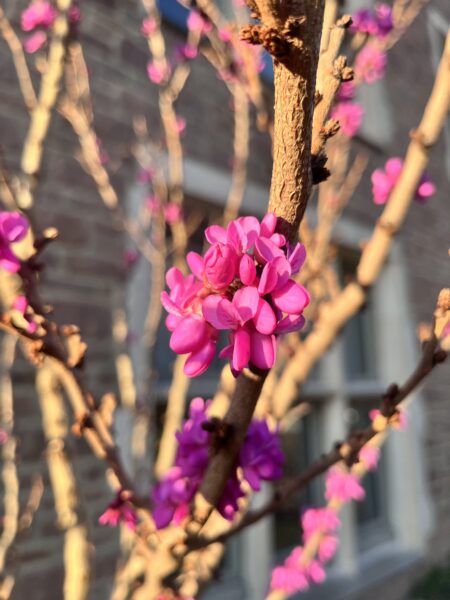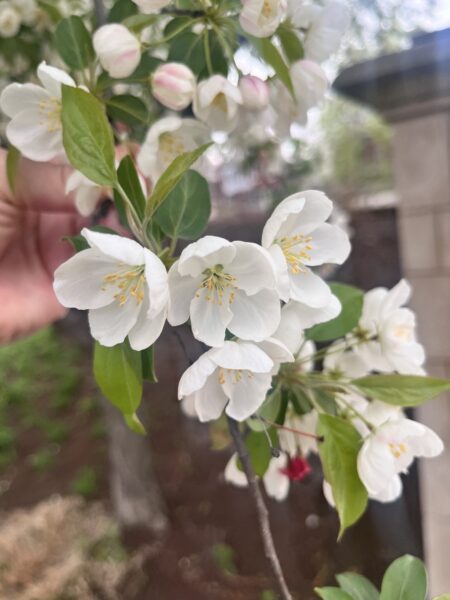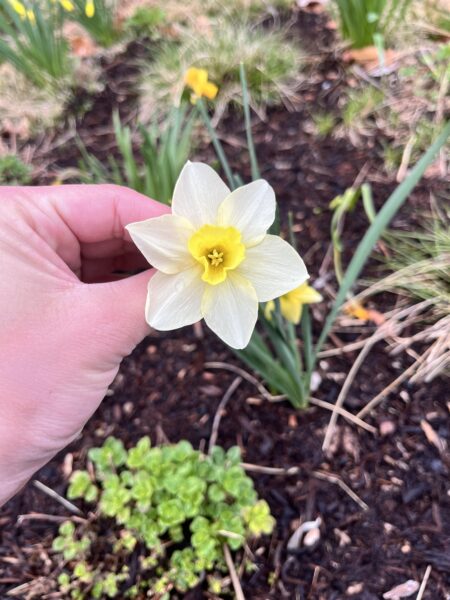Scene
Botany Guide 101
Spring has arrived, and with it comes the bloom of Washington University’s trees and flowers! As an intern for WashU’s Arboretum, the body of the 300 species and 6000+ trees on campus, I am constantly learning about the beautiful diversity of our campus’ trees and other plants that exhibit their life cycle processes throughout the year. Learning about plant identification has changed the way I view WashU: I feel the huge fuzzy magnolia buds in the winter between the DUC and Simon Hall, I imagine the corridor of chinkapin oaks that will eventually mature between Graham Chapel and Brookings Quad, and I brag to my friends about the clone of the original Brookings Basswood that I helped plant in a corner of the quad. By teaching about tree identification for our spring blooms, I hope to spread that perspective that has opened my eyes to the vibrant world of plants.
What’s In:
Eastern Redbud — Cercis canadensis
One of the biggest highlights of the early spring in St. Louis is the pink bloom of the Eastern redbuds. These trees may be less well-known than the cherry blossoms and their blooms near Lopata Hall, but they are nothing short of spectacular when they flower. As the Eastern redbud is a member of the pea family, its flowers are edible and make great additions to salads. If you do want to try this, please be mindful of the trees in WashU’s Arboretum and source your flowers off-campus.
- To identify: look for pink (or occasionally white) flowers that are irregularly five petalled—the two bottom petals are fused together, the two upper petals stick up like ears or wings, and the central petal has colored stripes on it to guide pollinators to the proper part of the flower. When flowers aren’t available, you can look for the heart-shaped leaves or the dried brown seed pods that may still be persistent on the branches through the past winter.
- To find: Eastern redbud trees are scattered across campus and in St. Louis. There are notable trees between Olin Library and Eads Hall, between the South 40 Underpass and the Simon parking lot heading towards the DUC, and there are rows of the white-flowered redbuds along the paths to the East End from main campus.

An Eastern Redbud. (Michael Barash | Student Life)
Flowering Crabapple – Malus spp.
WashU’s campus has multiple different varieties of flowering crabapple on campus. The curling, dome-shaped crabapple outside of Olin Library next to Ginkgo Allee is the most charismatic of these, with many students sitting by or inside the tree on a warm day to relax or create a unique study spot. In the fall, these trees produce their small, namesake crabapples which hang cherry-like from long stems.
- To identify: The flowers of the crabapples are similar to others in the rose family but can be distinguished by a couple key characteristics. They have five white petals that are not fused together but wide enough to slightly overlap, numerous long white stamens with yellow pollen-bearing anthers at their end, and an ovary that is inferior (below where the flower petals attach) — this can be found as a bulge in the base of the flower.
- To find: The domed flowering crabapple can be found next to Olin Library, the corner of Skinker and Forest Park Parkway, and in the Eliot Courtyard of the South 40.

A flowering crabapple. (Michael Barash | Student Life)
Daffodil – Narcissus spp.
These vigorously growing plants are neither native nor members of the Arboretum, but they are unmistakable across campus in early spring. As one of the earliest blooms of the season, these flowers seem to be holding on for another couple of weeks until the weather gets permanently warmer. Daffodils are monocots, placing them closer to onions, garlic, and lilies genetically than to most other dicot flowers.
- To identify: It helps to first identify the flower as a monocot: the absence of traditional leaves in favor of singular thick blade-like leaves and petals in multiples of three are both strong hints. The daffodil has flowers with six petals ranging in color from white to yellow, and a yellow hollow cylinder at its center that holds the stamens and pistil of the flower. Because of this, the flower is often described as trumpet-shaped.
- To find: These flowers can be found planted alongside paths all around campus, but find them quickly before they disappear for the year!

A daffodil up-close (Michael Barash | Student Life)
What’s Coming:
Flowering Dogwood – Benthamidia florida
The flowering dogwood is the state tree of Missouri, and when it blooms, it’s easy to see why. The large-bracted blooms of these trees are eye-catching and herald the arrival of spring warmth.
- To identify: The flowers of the flowering dogwood, ironically, are not even flowers. The four large white or pink “petals” are actually modified leaves called bracts, and the individual flowers are small, green, and clustered at the center. The bracts are often notched or reddened at their ends, helping to identify these flowers. The leaves of the dogwood are arcuate, meaning the side veins along the leaf curl upwards and meet at the tip, rather than out to the sides. Even without leaves or flowers, this tree can be identified by its twigs that branch out directly opposite one another at the same spot (as opposed to singular twigs branching at different points along the branch) and its upturned, cabbage-shaped buds.
- To find: The most noticeable flowering dogwoods on campus are across from the Gregg Storefronts in the South 40, although they are plentiful across campus, from the Village to the Swamp to Brookings Quad.
Tulip Poplar – Liriodendron tulipifera
The tulip poplar is one of the tallest broadleaf trees in North America, and it also boasts a wonderful bloom in April and May. Though they are related to magnolias, these trees can easily be distinguished by their massive size and unique leaves and flowers.
- To identify: the flowers of the tulip poplar are cup-shaped, with yellow-green petals that have orange markings at the base of the cup. The stamens are long, light yellow, numerous, and surround the large receptacle that holds many small pistils. The leaves are also distinguished by their two-forked shape that resembles the silhouette of a tulip in bloom.
- To find: The tallest tulip poplar on campus is behind Ginkgo Allee next to Holmes Lounge, but another large tree is outside the Busch Laboratory near “The Bunny.”
If you have any questions or want to set up an arbor walk for your student group, please reach out at [email protected] or explore our Arboretum.
